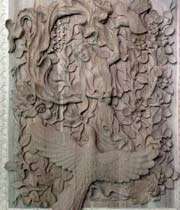Iranian Art: Wood carving (monabat)
As it is clear, by this art people would make ladder, carriage and house ware before the Achaemenidae dynasty; researchers have found relief design in which a girl is shown sitting and weaving in front of whom there is small table on which there are some fruits and a fish. Concerning the table it should be mentioned that the legs and the gap between them have been carving artistically, which indicates how familiar the artists were with this sort of art.
This art has also been positioned highly during the Achaemenidae and Sassanid periods. In the northeast of Persepolis, some clay inscriptions have been found the translation some of which indicate wage paying to the masters of inlaying art.
How to do woodcarving:
We fasten the piece of the wood which is going to be inlaid to the vice or it is fastened to the worktable manual vice.
The background of the surface can be carved with the flat gouge, which is called Woodcarving background. It can also be cut by drill and saw off the main design. Then after cutting around the background, the carved - latticed work is made. In carved - latticed work, the work is separated from the design, around which is later cut off. After that, some slight parts of the curves and inside the work are filed, which is called Seftkari or working on hand surface. After this stage, some oil is poured on the worked surface to make is fragile, oily surface is then ready for carving. After that the tip of the gouge is between slightly by the hand palm or an apparatus called Takhmagh to cut off around the work so that the background of the work is lowered as deep as needed; all the same is depth. Now it is the turned of polishing the job with gouge or some apparatus called Lisseh. In all stages of the work, weather in background work or in carving work, it is tried to move the gouges rightward to carve flowers and stems, which will the cause a good job. We then make some blows onto the tips of the different gouges with the palm of the hand to carve other parts of the job. In this way, according to the intended design, curves, straight lines concave and convex pars of the woodcarving are done.

Source: isfahan.ir
Other links:
Iranian Art Painting (Photo Gallery)
Photo Gallery of Gabbeh (Part1)
Photo Gallery of Gabbeh (Part2)
Iranian Art: Jajim Weaving
Iranian Carpets: Gabbeh
Qalamzani ( Photo Gallery)
Mina-kari ( Photo Gallery)
Khatamkari (Photo Gallery)
Iranian art: Termeh
Types of Jajim
Tapestry in Iran